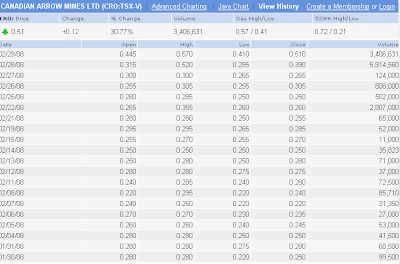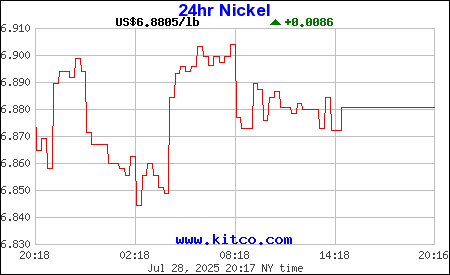



 Move your money out as I did...Here is a quick alternate nickel stock, .60 cents down from the high of 1.98 but a smaller float, TSX based , has bottomed and is moving back up,
Move your money out as I did...Here is a quick alternate nickel stock, .60 cents down from the high of 1.98 but a smaller float, TSX based , has bottomed and is moving back up, 

 DrillingThe well is created by drilling a hole 5 to 30 inches (13 – 76 cm) diameter into the earth with an oil platform which rotates a drill bit. After the hole is drilled, a steel pipe (casing) slightly smaller than the hole is placed in the hole, and secured with cement. The casing provides structural integrity to the newly drilled wellbore in addition to isolating potentially dangerous high pressure zones from each other and from the surface.With these zones safely isolated and the formation protected by the casing, the well can be drilled deeper (into potentially more-unstable and violent formations) with a smaller bit, and also cased with a smaller size casing. Modern wells often have 2-5 sets of subsequently smaller hole sizes drilled inside one another, each cemented with casing.
DrillingThe well is created by drilling a hole 5 to 30 inches (13 – 76 cm) diameter into the earth with an oil platform which rotates a drill bit. After the hole is drilled, a steel pipe (casing) slightly smaller than the hole is placed in the hole, and secured with cement. The casing provides structural integrity to the newly drilled wellbore in addition to isolating potentially dangerous high pressure zones from each other and from the surface.With these zones safely isolated and the formation protected by the casing, the well can be drilled deeper (into potentially more-unstable and violent formations) with a smaller bit, and also cased with a smaller size casing. Modern wells often have 2-5 sets of subsequently smaller hole sizes drilled inside one another, each cemented with casing.













 After drilling and casing the well, it must be 'completed'. Completion is the process in which the well is enabled to produce oil or gas.
After drilling and casing the well, it must be 'completed'. Completion is the process in which the well is enabled to produce oil or gas.
In a cased-hole completion, small holes called perforations are made in the portion of the casing which passed through the production zone, to provide a path for the oil to flow from the surrounding rock into the production tubing. In open hole completion, often 'sand screens' or a 'gravel pack' is installed in the last drilled, uncased reservoir section.
These maintain structural integrity of the wellbore in the absence of casing, while still allowing flow from the reservoir into the wellbore. Screens also control the migration of formation sands into production tubulars and surface equipment, which can cause washouts and other problems, particularly from unconsolidated sand formations in offshore fields.
After a flow path is made, acids and fracturing fluids are pumped into the well to fracture, clean, or otherwise prepare and stimulate the reservoir rock to optimally produce hydrocarbons into the wellbore. Finally, the area above the reservoir section of the well is packed off inside the casing, and connected to the surface via a smaller diameter pipe called tubing.
This arrangement provides a redundant barrier to leaks of hydrocarbons as well as allowing damaged sections to be replaced. Also, the smaller diameter of the tubing produces hydrocarbons at an increased velocity in order to overcome the hydrostatic effects of heavy fluids such as water.
In many wells, the natural pressure of the subsurface reservoir is high enough for the oil or gas to flow to the surface. However, this is not always the case, especially in depleted fields where the pressures have been lowered by other producing wells, or in low permeability oil reservoirs. Installing a smaller diameter tubing may be enough to help the production, but artificial lift methods may also be needed. Common solutions include downhole pumps, gas lift, or surface pump jacks.
The use of artificial lift technology in a field is often termed as "secondary recovery" in the industry. Many new systems in the last ten years have been introduced for well completion. Multiple packer systems with frac ports or port collars in an all in one system have cut completion costs and improved production, especially in the case of horizontal wells. These new systems allow casings to run into the lateral zone with proper packer/frac port placement for optimal hydrocarbon recovery.
[edit] Production
The production stage is the most important stage of a well's life, when the oil and gas are produced. By this time, the oil rigs and workover rigs used to drill and complete the well have moved off the wellbore, and the top is usually outfitted with a collection of valves called a "Christmas Tree". These valves regulate pressures, control flows, and allow access to the wellbore in case further completion work is needed. From the outlet valve of the Christmas Tree, the flow can be connected to a distribution network of pipelines and tanks to supply the product to refineries, natural gas compressor stations, or oil export terminals.
As long as the pressure in the reservoir remains high enough, this Christmas Tree is all that is required to produce the well. If the pressure depletes and it is considered economically viable, an artificial lift method mentioned in the completions section can be employed.
Petrolifera Petroleum Limited Cases Puesto Morales Este X-1001 Well
15:49 EST Thursday, February 28, 2008
CALGARY, Feb. 28 /CNW/ - Petrolifera Petroleum Limited (PDP - TSX) announces today that it has drilled, logged and cased the PME X-1001 well on its recently-acquired Puesto Morales Este Concession located in the province of Rio Negro in the Neuquén Basin, onshore Argentina.
The well encountered several zones of interest and will be evaluated once a service rig is available to conduct testing programs.




 Source
Source

First Nickel Provides 2008 Guidance
11:00 EST Tuesday, February 12, 2008
TORONTO, ONTARIO--(Marketwire - Feb. 12, 2008) - First Nickel Inc. (TSX:FNI) today provided guidance with respect to 2008 production.
The company expects:
- To produce between 3.8 and 4.4 million pounds of payable nickel, and
- To produce between 2.3 and 2.7 million pounds of payable copper.
First Nickel has budgeted $17 million for development and capital improvements at the Lockerby Mine and expects to spend approximately $7 million on exploration the majority of which will be spent on targets around the existing Lockerby Mine infrastructure, Lockerby East and footwall areas. Funding for these expenditures will come from existing cash balances and cash flow generated from the Lockerby operations.
William Anderson, President and CEO states, "We look forward to a significantly improved 2008. I am pleased that the Board has authorized expenditures designed both to improve our existing production profile and to ramp up our aggressive exploration programs on our various, highly prospective properties in the Sudbury area."
First Nickel is a Canadian mining and exploration company. Its current activities are primarily focused on the Sudbury Basin in northern Ontario, the location of the company's producing property (the Lockerby Mine) and four of its exploration properties. First Nickel also has two exploration properties in the Timmins region of northern Ontario. First Nickel's shares are traded on the TSX under the symbol FNI.
This news release may contain forward-looking statements, which are subject to certain risks, uncertainties and assumptions. A number of factors could cause actual results to differ materially from the results discussed in such statements, and there is no assurance that actual results will be consistent with them. Such forward-looking statements are made as at the date of this news release, and the company assumes no obligation to update or revise them, either publicly or otherwise, to reflect new events, information or circumstances, except as may be required under applicable securities law.
FOR FURTHER INFORMATION PLEASE CONTACT:First Nickel Inc.W.J. AndersonPresident & CEO(416) 362-7050(416) 362-9050 (FAX)Email: wanderson@firstnickel.com
First Nickel Reports 289% Increase in Indicated Resources at the Lockerby Mine1/16/2008
-->
Investor Update Conference call at 2:00 pm ET todayTORONTO, ONTARIO, Jan 16, 2008 (MARKET WIRE via COMTEX News Network) --
First Nickel Inc. (TSX: FNI) is pleased to report an updated mineral resource estimate for its Lockerby Mine in Sudbury.
First Nickel has estimated a NI 43-101 compliant Mineral Resource that contains Indicated Resources of 2.89 million tonnes grading 1.78% Ni, 1.23% Cu and 0.07% Co, from the 65 to 72 levels, and Inferred Resources of 0.38 million tonnes grading 1.37% Ni, 1.05% Cu and 0.05% Co, below the 72 Level. A 1.0% nickel equivalent cut-off grade was used for this resource estimate. The resource estimate does not include the 64 Level, which was part of the March 2007 resource estimate and is currently being mined.
This upgraded resource estimate equates to a total of 113 million pounds of contained nickel in the Indicated Resource Category for the Lockerby Depth Zone and represents a net increase of 68 million pounds as compared to those previously reported in March 2007.
"The potential of the Lockerby Depth Zone has expanded significantly with an increase of the Indicated Resources by 289% above the March 2007 Resource Estimate. We are gratified that, when compared to the Indicated Resources at the time of purchase of the Lockerby Mine in 2005, we have increased the Indicated Resources more than ten-fold in less than 3 years." stated William Anderson, President and CEO. "
Based on this new Resource Estimate, the Lockerby Mine currently has in excess of 100 million pounds of contained nickel in the Indicated Resource category which should allow First Nickel to plan for mine expansion and increased production."
Using this estimate, First Nickel expects to complete a new life of mine study this quarter that will include engineering and economic comparisons of shaft extension options and mine design.
It is anticipated that such infrastructure improvements, based on the new resource model, will yield increased output, better productivity, reduced costs and will extend the mine life by 8 years or more.
Mineral Resource Estimate
The Mineral Resource model was prepared by the FNI Technical Team. The model and modelling procedures have been reviewed by Scott Wilson Roscoe Postle Associates Inc. (Scott Wilson RPA), an independent, geological and mining consulting firm. In Scott Wilson RPA's opinion the mineral resource modeling and the Mineral Resource estimation, conform to NI 43-101 standards. In Scott Wilson RPA's opinion, the density of drilling and continuity of mineralization is sufficient to classify the estimated resources between the 65 and 72 levels on the Lockerby Depth Zone as Indicated Mineral Resources and below the 72 Levels on the Lockerby Depth Zone and the previously reported Lockerby East Zone as Inferred Mineral Resources. This resource estimate will form a portion of a more comprehensive Technical Report being prepared by Scott Wilson RPA.
Source+More